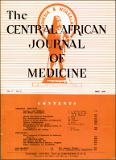| dc.contributor.author | Bader, Simon | |
| dc.date.accessioned | 2015-11-30T20:39:26Z | |
| dc.date.available | 2015-11-30T20:39:26Z | |
| dc.date.issued | 1956-05 | |
| dc.identifier.citation | Bader, S. (1956) The muscle relaxants in anaesthesia, CAJM vol. 2, no. 5, pp.185-191. UZ (formerly University College Rhodesia), Harare (formerly Salisbury: Faculty of Medicine. | en |
| dc.identifier.issn | 0008-9176 | |
| dc.identifier.uri | https://opendocs.ids.ac.uk/opendocs/handle/20.500.12413/7158 | |
| dc.description | A CAJM article on muscle relaxants in anesthetic practice. | en |
| dc.description.abstract | It may be stated that the use of the muscle relaxants represents a tremendous advance in anaesthetic practice. Prior to their introduction, muscular relaxation, especially in abdominal surgery, was brought about by chloroform or ether anaesthesia. But the complications following on the use of these agents were so frequent as to warrant the use of other methods, including spinal analgaesia, nerve block and infiltration with local anaesthetic substances in order to produce the maximum amount of muscular relaxation. The introduction of curare and the closely related group of drugs known as the “muscle relaxants” into anaesthetic practice have eliminated these techniques. | en |
| dc.language.iso | en | en |
| dc.publisher | Faculty of Medicine, Central African Journal of Medicine (CAJM), University College of Rhodesia (now University of Zimbabwe) | en |
| dc.rights.uri | http://creativecommons.org/licenses/by-nc-nd/3.0/ | en |
| dc.subject | Health | en |
| dc.subject | Science and Society | en |
| dc.title | The muscle relaxants in anaesthesia | en |
| dc.type | Article | en |
| dc.rights.holder | University of Zimbabwe (UZ) (formerly University College of Rhodesia) | en |


